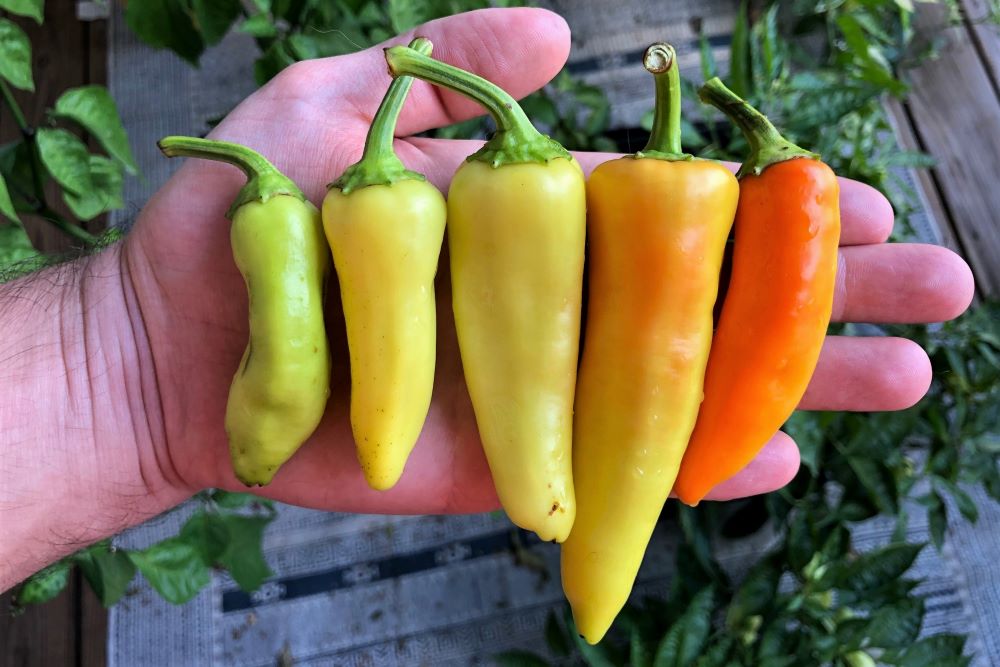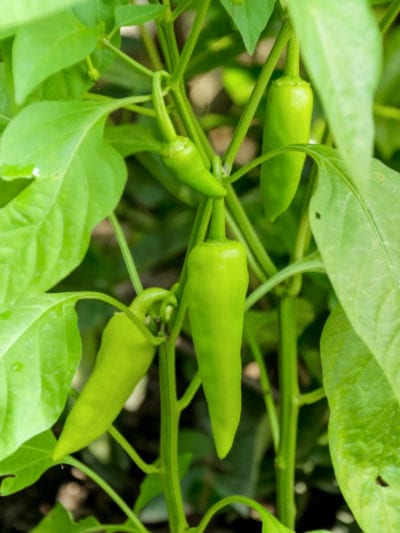To plant banana peppers, prepare a well-drained, sunny spot in your garden and sow the seeds approximately 1/2 inch deep in rows, spacing them 18 to 24 inches apart. Water regularly and provide support for the plants as they grow.
Growing your own banana peppers can be a rewarding experience that allows you to enjoy their spicy sweetness whenever you desire. Whether you plan to use them in salsas, salads, or as a topping for your favorite dishes, learning how to plant banana peppers is a simple and straightforward process.

Credit: peppergeek.com
By providing the right conditions and care, you can cultivate healthy pepper plants that will yield a bountiful harvest. We will guide you through the steps to successfully plant banana peppers in your garden, allowing you to add a flavorful kick to your culinary creations. Let’s get started!
How to Plant Banana Peppers : Step by Step Guide
Choosing The Right Variety Of Banana Peppers
Choosing the right variety of banana peppers is essential for a successful harvest. When selecting banana pepper varieties, there are several factors to consider. First, think about the purpose of growing banana peppers. Are you planning to use them fresh or for pickling? Popular varieties for home gardens include Sweet Banana, Hungarian Wax, and Marconi. These varieties offer a mild to medium heat level, making them suitable for various culinary uses. When buying banana pepper seeds or seedlings, make sure to look for reputable sources. Check the seed packet or plant label for information on heat level, fruit size, and days to maturity. It’s also helpful to read reviews or ask fellow gardeners for recommendations.
Preparing The Soil For Planting Banana Peppers
One important step in preparing the soil for planting banana peppers is testing the soil pH. This will help determine if any amendments are needed to create the optimal growing conditions. Using a soil testing kit, you can easily check the pH level and make adjustments if necessary.
Next, it is vital to prepare the soil by tilling and removing weeds. This will ensure a healthy environment for the pepper plants to grow. Tilling helps break up compacted soil, allowing better root penetration and nutrient absorption.
In addition to tilling, adding organic matter to the soil can greatly improve its fertility. This can be done by incorporating well-rotted compost or aged manure into the soil. Organic matter helps with moisture retention, nutrient availability, and overall soil health.
| Benefits of Preparing the Soil |
|---|
| Optimal pH: Testing the soil pH ensures the right acidity level for banana peppers. |
| Weed Control: Removing weeds reduces competition for nutrients, water, and sunlight. |
| Better Root Growth: Tilling helps create a loose soil structure, allowing roots to penetrate easily. |
| Enhanced Nutrient Uptake: Adding organic matter improves the availability of essential nutrients to the plants. |
| Improved Soil Fertility: Organic matter enhances soil health and fertility over time. |
Planting Banana Pepper Seeds
When planting banana peppers, one of the first steps is to select the perfect location. It should be a sunny spot with well-drained soil. Avoid areas with excessive shade or moisture accumulation, as these conditions can hinder plant growth.
Next, prepare seed trays or pots for germinating the banana pepper seeds. Fill them with a well-balanced potting mix and make sure they have drainage holes to prevent waterlogging.
After preparing the seed trays, it’s time to sow the banana pepper seeds. Place one or two seeds in each tray or pot, covering them with a thin layer of soil. Water the seeds gently, ensuring that the soil is moist but not saturated.
Provide the germinating seeds with proper light conditions. Banana peppers thrive in full sunlight, so place the trays or pots in a sunny area or use grow lights for indoor cultivation.
Continue to water the seedlings regularly, keeping the soil evenly moist. Avoid overwatering, as it can lead to root rot. As the seedlings grow, thin them out to ensure proper spacing.
Transplanting Banana Pepper Seedlings
Transplanting banana pepper seedlings outdoors can be done once the risk of frost has passed and temperatures consistently reach around 60-70°F. Dig planting holes that are wide and deep enough to accommodate the root ball of the seedling. Make sure to space the seedlings about 12-18 inches apart in rows that are around 2-3 feet apart.
Take care when transplanting the seedlings to avoid damaging the delicate roots. Gently loosen the soil around the seedling without disturbing the root system. Place the seedling into the planting hole and backfill it with soil, making sure the transplant is at the same depth as it was in the original container.
Water the seedlings thoroughly after transplanting to help them settle in their new location. Apply a layer of mulch around the base of the plants to help retain moisture and suppress weed growth. Regularly monitor and water the seedlings to ensure they establish well and thrive in their new outdoor environment.
Caring For Banana Pepper Plants
Regularly watering your banana pepper plants is essential to maintain moisture levels. Be sure not to overwater, as this can lead to root rot. Watering deeply once a week is usually sufficient, but you may need to adjust depending on the weather conditions.
Applying organic fertilizer to your banana pepper plants will help promote optimal growth and fruit production. Use a balanced fertilizer with equal parts nitrogen, phosphorus, and potassium. Apply the fertilizer about 4-6 weeks after transplanting and repeat every 4-6 weeks throughout the growing season.
Controlling pests and diseases that commonly affect banana pepper plants is crucial for their overall health. Monitor your plants regularly for signs of pests such as aphids, caterpillars, or mites. If detected, treat them with organic pest control methods such as neem oil or insecticidal soap. Also, keep an eye out for diseases like leaf spot or bacterial wilt and take preventive measures.
Harvesting And Storing Banana Peppers
Determining the right time to harvest banana peppers is crucial in order to ensure optimal flavor and quality. One way to identify the right time is by looking at the color of the peppers. When they have reached a vibrant yellow or red shade, they are ready to be picked. Another method is to gently squeeze the pepper. If it feels firm and full, it is ripe and can be harvested.
To properly harvest banana peppers, it’s important to use a sharp pair of shears or scissors to cut the stem of the pepper as close to the plant as possible. This helps to prevent damage to the plant and future growth. Be sure to wear gloves when handling the peppers as some varieties can irritate the skin.
Storing banana peppers is relatively easy and can ensure a longer shelf life. It is best to keep them in a cool, dry place such as a refrigerator. Place them in a perforated plastic bag to allow for airflow. Alternatively, you can freeze the peppers by slicing them and placing them in a freezer-safe bag. When properly stored, banana peppers can last for several weeks to a few months, allowing you to enjoy their tangy flavor long after harvest.
Cooking And Enjoying Banana Peppers
Banana peppers are a versatile ingredient that can add a burst of flavor and color to a variety of dishes. Whether you prefer a mild or spicy kick, there are plenty of ways to enjoy these vibrant peppers. When it comes to popular recipes, banana peppers are often featured in pizzas, sandwiches, and salads. Their tangy and slightly sweet taste adds a delightful twist to these dishes, making them a hit among pepper lovers.
If you have an abundant supply of banana peppers, preserving them through pickling and canning is a great option. This not only extends their shelf life but also amplifies their flavor. Pickled banana peppers make a tasty addition to sandwiches, wraps, and charcuterie boards.
Looking for more creative ways to use banana peppers? Try stuffing them with cream cheese or using them as a topping for nachos. They can also be diced and added to omelets, stir-fries, or even grilled cheese sandwiches for an extra zing. Whatever you decide, banana peppers are sure to elevate your culinary creations.
Troubleshooting Common Problems With Banana Pepper Plants
Yellowing leaves can be a common issue when growing banana peppers. It is essential to identify and treat this problem promptly to ensure the health of your plants. One common cause of yellowing leaves is a lack of nutrients, particularly iron. Address this by using a fertilizer rich in iron or adding organic matter to the soil. Another culprit could be overwatering, which leads to root rot. Ensure proper drainage and only water when the soil is dry to the touch.
Blossom-end rot is another concern for banana pepper plants. It appears as a dark, sunken spot on the bottom of the fruit. This problem is caused by calcium deficiency or inconsistent watering. Maintain consistent moisture levels and provide adequate calcium through fertilizers or amendments like crushed eggshells.
Fungal diseases, such as powdery mildew and blight, can also affect banana pepper plants. To prevent these issues, make sure there is sufficient airflow around the plants and avoid excessive overhead watering. If fungal diseases do occur, treat them with appropriate fungicides or organic remedies like neem oil.
Frequently Asked Questions For How To Plant Banana Peppers
What Month Do You Plant Banana Peppers?
Banana peppers are usually planted in spring, typically during the months of April or May.
How Do You Plant Banana Peppers In The Garden?
To plant banana peppers in the garden, follow these steps: 1. Choose a sunny spot with well-drained soil. 2. Dig a hole, slightly larger than the plant’s root ball. 3. Place the plant in the hole and cover with soil, gently firming it down.
4. Water the plant regularly, keeping the soil evenly moist. 5. Provide support for the plant, such as a stake or trellis, as it grows. 6. Harvest the peppers when they reach the desired size and color.
Where Is The Best Place To Plant Banana Peppers?
The best place to plant banana peppers is in a sunny location with well-drained soil.
How Much Space Does A Banana Pepper Plant Need?
A banana pepper plant needs ample space to grow properly in your garden.
Conclusion
Planting banana peppers is a straightforward process that can be done by anyone, even if you have limited gardening experience. By following the right steps, you can ensure the success of your banana pepper plants and enjoy a bountiful harvest.
Remember to choose a sunny location with well-drained soil, prepare the soil by adding compost, and space the plants properly to allow for optimal growth. Water your banana peppers consistently, but be careful not to overwater, as this can lead to root rot.
Additionally, it is important to use organic fertilizers and keep an eye out for pests or diseases. With a little patience and care, you can have a thriving banana pepper garden in no time. So, roll up your sleeves, get your gardening tools ready, and enjoy the delicious rewards of growing your own banana peppers.

